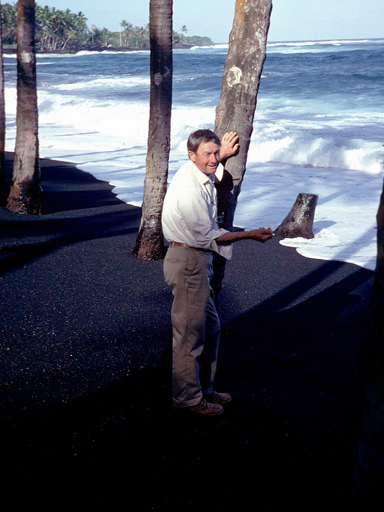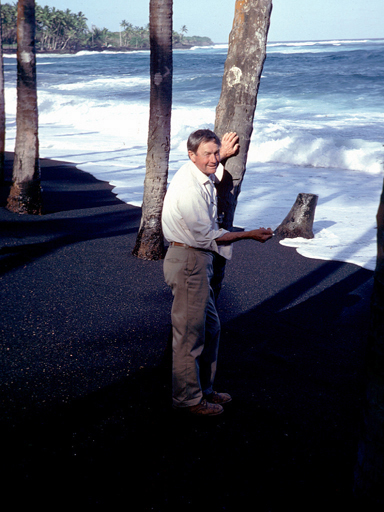In Memoriam
Robert P. Sharp
(1912–2004)

R. P. Sharp on Kalapana Black Sand Beach, Hawaii, Summer 1978
Robert P. Sharp, Professor Emeritus, California Institute of Technology, died on 25 May 2004. Sharp was a mentor to and close friend of MSSS President and Chief Scientist Mike Malin; they spent many years conducting collaborative research and, occasionally, fly fishing at Sharp’s cabin in Montana.
In 1996, Malin was asked to provide the Geological Society of America’s Quaternary Geology and Geomorphology Division a letter in support of the nomination of Sharp for the Division’s Distinguished Career Award. This is that letter:
8 April 1996
This letter is written in support of the nomination of Prof. Robert P. Sharp for the 1996 GSA Quaternary Geology and Geomorphology Division Distinguished Career Award. I cannot imagine a stronger candidate for this award; indeed, I am astonished that he has not previously received this award. I can only surmise that he remains so productive that most of us have found it hard to determine when to say his career has reached its pinnacle.
I normally keep letters of recommendation to one page, figuring that the committee evaluating candidates has many items to read and a long-winded exposition of things they already know is the least they need to see. This is a challenge to myself that I may not be able to meet here, so I beg the Committee’s indulgence if I take a little extra space to discuss his qualifications for this award, even without going into a chronological history of his career. I must note at the outset that, above all, Bob is in my view the quintessential field geologist. He loves the field and field work. His career and field work are inseparable. He fully follows in the tradition of Gilbert and Bryan.
In many ways, Bob’s career has spanned and contributed in a major way to an important evolution of the fields of Quaternary Geology and Geomorphology. He is of a generation primarily trained in qualitative studies, yet he pioneered the application of rigorous analytical and quantitative techniques (both in terms of computation and physical measurement) to both fields.
Like a great artist, his career has gone through many stages, some building methodically on previous experience, others representing imaginative, innovative ventures into unknown but ultimately fertile ground. Unlike many in our field, he rarely treads over the same ground twice–his publication record is remarkable not only in its breadth but in the absence of substantial duplication.
Bob is an advocate of topical research, a term used to describe targeted studies of very specific problems that often have broader consequences. He attacks big issues in small pieces. Thus, his bibliography does not include a career-summarizing tome that encompasses the first real publication of thirty years of effort. He prefers to work on and publish four topical papers of 20 pages each to one 80 page monograph. This has, in many ways, greatly enriched the community, for it provides essential views and data, in refereed journals, while the work is still fresh and of interest.
Although he has made important contributions to many subdisciplines in geomorphology, let me here highlight truly seminal contributions in two areas: arid region geomorphology and extraterrestrial geology. In the former area, Bob’s two fundamental contributions reflect a commitment to and long distance view of the field few of us can equal. To study the nature of motion of sand dune fields, he established a test site in the Algodones dunes and observed and repeatedly measured that site for 12 years. In the study of wind abrasion, he collected wind-borne sand samples and recorded the effects of abrasion on exposed materials for 16 years. Both studies are so rich in observations that they are still being mined by investigators developing analytical and numerical models and simulations of these processes. The primary contribution of the former study is the recognition and demonstration that, in areas with limited sand supplies, dune field formation, location, and migration reflects a complex but understandable and quantifiable interplay of wind and surface conditions. The primary contributions of the latter are the understanding that abrasion rarely occurs as a uniformitarian process (but is rather the result of short duration, high energy events), and that particles within the saltating curtain are highly segregated, with different particle sizes following different frequency/height relationships (potentially the explanation for eolian sorting).
Another example of Bob’s field approach is his study of wind ripples. This work revealed, by detailed field inspection and measurement and laboratory study including the impregnation and sectioning of ripples, the relative simplicity of the nature and movement of ripples. A profound result of this work, still ignored by some eolian geologists, is his refutation of Bagnold’s idea that ripple dimension reflects a characteristic grain path length.
In the study of other planets, Sharp’s primary contributions come not only in a few, fundamental papers, but in the manner he helped guide other investigators in shaping their own works during the formative years of non-lunar, extraterrestrial geology. For example, I have a copy of a proposal prepared by Robert Leighton, Bruce Murray, and Sharp (the senior of the three), dated May 1961, to the National Aeronautics and Space Administration, in which they propose that a camera be flown on the first spacecraft mission to Mars. Leighton was the principal investigator, responsible for the instrument; Sharp the co-investigator responsible for what was to be done with the data. This document appears to have established not only the specific details of what became the highly successful imaging experiments on Mariners 4, 6 and 7, but also the form, format, and substance for science participation in subsequent deep space exploration, as the proposed tasks and approach are essentially identical to modern mission requirements as specified by NASA. The scientific objectives and anticipated results are as clear an exposition of how one uses photography to study geology at scales from tens of kilometers to hundreds of meters as could possibly be written. Indeed, I could cite no less than ten papers, each written by imaging teams for subsequent missions, whose technical approach basically mimics that proposed, and ultimately used, by Sharp, Leighton, and Murray.
However, it is in the science analysis, and in his thorough review and critique of himself and his co-workers, that he most aided the embryonic science. Bob brought firm and uncompromising observational experience to a field often overpowered by speculation. He acted as an anchor to the flightful fantasies of his colleagues. Scientifically, our views of several unusual terrains on Mars remain today fundamentally unaltered from those he first expressed in three spectacular papers published in the July 1973 issue of Journal of Geophysical Research. Other papers in that issue owe their importance to their precedence (for example, the first paper about martian volcanoes, or the first paper about water erosion on Mars); Sharp’s owe their importance to the recognition of and insight into unusual processes otherwise unfamiliar and/or unknown.
Bob would be greatly offended if I did not also note his commitment to teaching as an important, if not the most important, attribute of his career. Bob is not only a superb graduate educator (a list of his students, and those on whose committees he served, is a veritable Who’s Who of prominent geologists and geomorphologists), but he has an unswerving dedication to undergraduate and lay-public education that has, in some ways, led to his greatest career successes. His two “Field Guide” contributions to Kendell-Hunt’s series (“Southern California” and “Coastal Southern California”) are “best sellers” in the market; his more technical discussions of glaciation in the Sierra Nevada are, by my own first hand experience, common knowledge to local residents to whom Bob’s prose style is easily accessible. I know of no better recommendation than the number of geologists who have chosen their career after taking introductory geology from Bob.
When I was a student at Caltech (1971-1975), Sharp was nearing the “end” of what most scientists would consider the productive portions of their careers, based on chronological age. In his early 60’s at the time, his technical efforts had encompassed glacial geology, glacial deposits and their sedimentological near-neighbors landslides and earthflows, and glaciology. He had initiated and completed topical and decade-long studies in the Mojave Desert addressing weathering and erosion of both bedrock and regolith materials, and wind transport of sand and its geomorphic effects. He had been the first geologist to study planets other than the Moon, and the first to concentrate on non-crater landforms. This would have been an impressive career, and in acknowledgment, he received, among many other honors, the GSA’s Kirk Bryan and G. K. Gilbert Medals, and was named a member of the National Academy. Yet, subsequently and indeed continuing considerably after his formal “retirement” from Caltech, he has ventured into studies of pyroclastic volcanic eruptions in Hawaii, Viking Lander images of the surface of Mars, microstratigraphy of alluvial surfaces in the Mojave Desert, and continued studies of glaciers and glaciation, desert processes, and extraterrestrial landforms and processes. He continued to be extremely active in student education, teaching his Geomorphology Field Class and Field Geology long after his “retirement,” and leading “expeditions” of senior undergraduates to Hawaii to experience volcanism first-hand.
Bob Sharp has had, and continues to have, quite a career. Certainly one worthy of the recognition of his peers, and of the Division.












 Copyright 2023 All rights reserved.
Copyright 2023 All rights reserved.